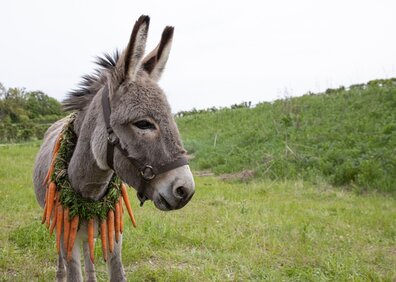
EO
Studio: Sideshow and Janus Films
Director: Jerzy Skolimowski
Nov 26, 2022
Web Exclusive
![]()
For better or worse (and it’s mostly worse), much of the 21st Century cinematic landscape has been defined by an urge to recycle IP. Straight remakes gave way to reboots, gave way to legacy sequels, gave way to whatever wicked multiverse ploy Disney has planned next. But that tendency to reimagine isn’t modern in itself—our entire storytelling tradition is built on the idea of iterating on prior tales, from Arthurian knights to the changing masks of Noh theatre. And so enters EO, director Jerzy Skolimowski’s contemporary retelling of Robert Bresson’s landmark 1966 feature, Au Hasard Balthazar, that finds nuance in such retellings.
For those unfamiliar with the original, Au Hasard Balthazar and EO both centre on that most humble of god’s creatures: the donkey. In each version, the broad strokes remain the same: said donkey is subject to some of humanity’s worst impulses, driven between uncaring and abusive owners with only brief moments of kindness to act as respite. But in modernising the narrative, Skolimowski not only invents a new series of characters and locations for the donkey, EO, to journey between, but layers in contemporary considerations around the role of the mule (and indeed all animals) in cinema and the world at large.
Fittingly, we first encounter EO on the job, performing an elaborate routine as part of a travelling circus in Poland. Bathed in the same lurid lighting most often associated with red light districts, EO rolls and dances in front of a small crowd, his large eyes gleaming under the flashes. That his handler and dance partner, Kasandra (Sandra Drzymalska), is one of the few characters to treat him with any respect and compassion speaks volumes to the indifference and ignominy EO is faced with. After the circus is closed for its use of animal performers, each of EO’s successive owners either see him as easy labour, meat for slaughter, or a potential meal ticket—and often all three.
From the strobing lights of the opening sequence on, Skolimowski firmly asserts his own cinematic language, working with cinematographer Michał Dymek to place the audience in the shoes (or hooves) of the prong-eared mammal. Told mostly through handheld shots at EO’s eye level, with a tendency for extremely shallow focuses and distorted lenses, there’s a constant awareness that our perspective is being limited. Wide shots are reserved for the film’s more abstract sequences; further disorienting light shows or melancholy profiles of EO against an unwelcoming landscape. Of Bresson’s own penchant for sparse static framing, there is little.
Driven ever forwards (and occasionally overwhelmed) by composer Pawel Mykietyn’s stirring score, EO’s pursuit of some unknown comfort is profoundly compelling on two fronts. The first, its simplicity, gives the film a forward momentum that Skowlimowski and Dymek’s roving camera capitalises on repeatedly, ever displacing the present moment. The second, its unspoken nature, forces the audience to question what peace even constitutes to an animal reared for entertainment. The answers may not be forthcoming, but a profound emotional response remains.
Author rating: 8/10
Average reader rating: 8/10
Current Issue

Issue #72
Apr 19, 2024 Issue #72 - The ‘90s Issue with The Cardigans and Thurston Moore
Most Recent
- Under the Radar Announces The ’90s Issue with The Cardigans and Thurston Moore on the Covers (News) — The Cardigans, Thurston Moore, Sonic Youth, Garbage, The Cranberries, Pavement, Lisa Loeb, Supergrass, Spiritualized, Lush, Miki Berenyi, Miki Berenyi Trio, Emma Anderson, Hatchie, Ride, Slowdive, Velocity Girl, Penelope Spheeris, Terry Gilliam, Gus Van Sant, Ron Underwood, Kula Shaker, Salad, Foals, Semisonic, The Boo Radleys, Stereo MC’s, Pale Saints, Blonde Redhead, Sleater-Kinney, Cocteau Twins, Lucy Dacus, Alex Lahey, Horsegirl, Grandaddy, alt-J, Squid, The Natvral, Wolf Alice, Jess Williamson, Sunflower Bean, Orville Peck, Joel McHale
- Fresh Shares New EP ‘Merch Girl’ (News) — Fresh
- Premiere: LOVECOLOR Shares New Video for “Crazy Love” (News) — LOVECOLOR
- Final Summer (Review) — Cloud Nothings
- Tallinn Music Week, Tallinn, Estonia, April 3-7, 2024 (Review) — Virta, Musta Huone, Mari Kalkun, Sven Grünberg

Comments
Submit your comment
There are no comments for this entry yet.